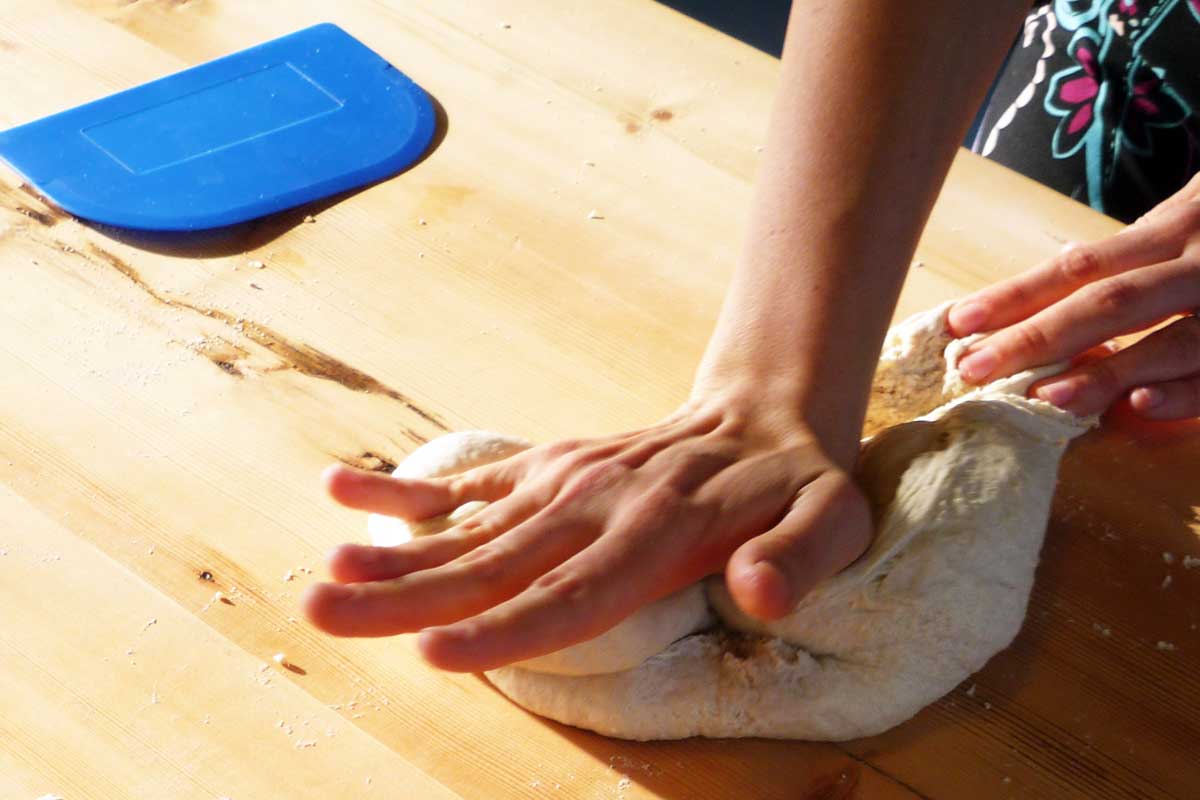Sustain / Real Bread Campaign / Articles
To knead or not to knead?
Steven Croft investigates the reasons a baker might and might not.

Kneading seems to have a mystical, almost alchemical aura that makes it equally enthralling and intimidating for new bread makers. Virtuous Bread founder Jane Mason, who is currently working on a film celebrating breadmaking across the globe, suggests the reasons to knead stretch beyond simply practical ones to social and psychological possibilities. “People love to knead. There is a lot of laughter and chatter,” she says.
Zen
One person quoted in Rising Up, the Campaign’s study of various therapeutic benefits of Real Bread making, described “...the Zen-like calm of hand mixing the dough; the way your life slowly becomes aligned around the rising of dough and the fermenting of leaven.”
A little bit of science
If you’re interested in a less kneady physical relationship with dough, fear not. Scientifically speaking, kneading dough is little more than a means of speeding a bio-chemical process. In the presence of water, molecules of glutenin and gliadin (two proteins found in wheat) form bonds to create a gluten network. Adding physical energy is one way of assisting the bonding process, but another is to add more water and/or time.
By learning to work with wetter doughs and longer fermentation times, creative bakers can not only exploit the property of water to reduce the amount of kneading required but also create wonderful holey and wholesome breads whose doughs almost defy attempts to knead them. A glistening pillow of ciabatta dough waiting to be divided and gently stretched into slipper shapes is a lovely sight.
No knead doughs
Yet as I hear myself describing them I can’t help but think that I’m approaching this from the wrong direction. I’m not making an art installation, or writing a poem. I want bread making to be at the heart of people’s lives in a way that is practical, nourishing and useful. If discovering that we don’t have to knead so much – or at all - teaches us anything, it’s that there are even more ways to help people introduce Real Bread making into their lives. Knead if you like, but if you always thought breadmaking was not for you because of the need to knead, help is at hand.
For people who find that the squeezing and stretching of dough is not possible, say due to arthritis or weakness in their hands, no-knead doughs may be a solution. With his no knead recipe published by Mark Bittman in the New York Times in 2006, and his 2009 book My Bread, Jim Lahey, reportedly revolutionised home bread making in New York and beyond. He showed how thick crusty breads of a quality usually associated with the best artisan bakers, could be made with less effort than used in traditional methods. Using wetter doughs and a dutch oven or lidded casserole to simulate bakery oven conditions, he showed that virtually no kneading is required.*
For those still sceptical about skimping on working the dough, food scientist Harold McGee sets out in his book On Food and Cooking how the chemical processes that result in the formation of a gluten network really do not need much help from us other than to introduce flour to water.
Less kneady
And if all that science sounds too much like school, Suzanne Dunaway’s 1999 book No Need to Knead uses lovely descriptions of her New York/Italian upbringing to make the point that the there is no place for a dough-wrangler in her kitchen. Each author makes the case that no matter how much we might enjoy wrestling a few kilogrammes of sticky mass into silky submission, we don’t have to do it.
Home bakers have the advantage over professionals in that they do not necessarily need to fit their baking into an eight-hour bakery shift, when some form of kneading or dough manipulation is more or less essential. Yet it is still possible to reduce the amount of kneading. Bakers at BBC Food and Farming Award finalist E5 Bakehouse, for example, stretch and fold dough at intervals rather than carry out a single, concerted knead.
Your choice
And this is all before we even consider no or low-gluten flours. Take certain pure rye breads, which require little to no dough manipulation to create rich and flavourful breads.
Ultimately, using a range of techniques, recipes and flours will give a baker the tools to make breads to suit both moods and purpose. Whether you are a gentle massager, a Bertinet slapper, or a Whitley concertina-squeezer**; whether you need a physical and emotional work out on a tight, close-textured tin dough, or a no-fuss, no-knead wholly holey loaf, to knead or not to knead is up to you.
You can read more by Steven at www.carefulfood.org.uk
@crofty
@harold_mcgee
@jimlaheySSB
@e5bakehouse
@virtuousbread
Originally published in True Loaf magazine issue 24, July 2015
*While the NYT still describes Lahey's as 'one of the most popular recipes The Times has ever published,' he did not invent the no knead technique. As noted above, for example, Suzanne Dunaway's book predates Lahey's NYT article by more than six years. In a 2021 article for Eater, Danya Evans calls Dunaway The Women Erased From the Story of No-Knead Bread. [ed.]
**An online search for videos of the dough working techniques used by each of these past Real Bread Campaign ambassadors will help you to verify the accuracy of the descriptions. [ed.]
Published Monday 11 October 2021
Real Bread Campaign: Finding and sharing ways to make bread better for us, our communities and planet.

